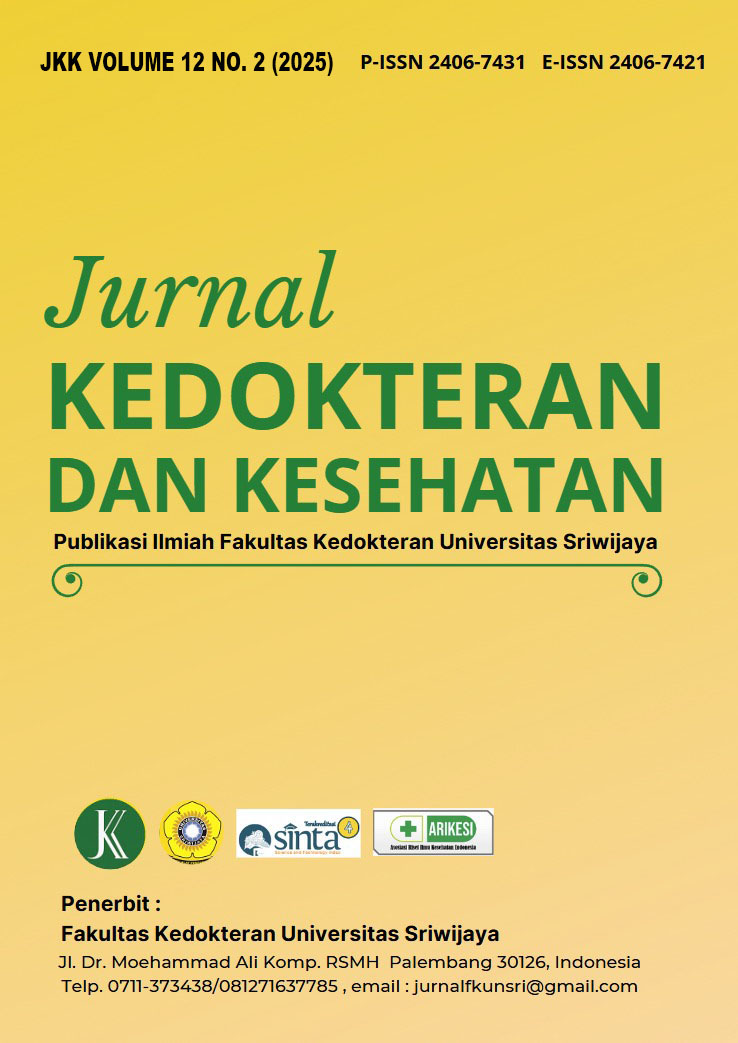DISTRIBUTION AND INTENSITY OF MUSCULOSKELETAL PAIN AMONG RECREATIONAL DEADLIFT USERS IN PALEMBANG: A CROSS-SECTIONAL STUDY
Main Article Content
Deadlift is a resistance training exercise commonly used to enhance muscle strength, but improper technique can increase the risk of musculoskeletal pain. This study aimed to analyze the distribution and intensity of musculoskeletal pain in recreational deadlift users using a cross-sectional design. A total of 42 respondents from two gym communities in Palembang were selected through purposive sampling. Data were collected via questionnaires and analyzed descriptively. The results showed that 48.9% of respondents had poor posture during deadlift, and the majority (66.7%) lifted heavy loads (≥70% of 1RM). Musculoskeletal pain was most frequently reported in the lower back (85.3%), followed by the glutes (8.8%) and the right shoulder (5.9%). Most respondents experienced mild pain (37.8%) or no pain at all (37.8%), while moderate pain was reported by 24.4% of respondents. No cases of severe pain were recorded. These findings indicate that although deadlift can cause musculoskeletal discomfort, the pain intensity is generally tolerable.
2. Heidari E, Arjmand N, Kahrizi S. Comparisons of lumbar spine loads and kinematics in healthy and non-specific low back pain individuals during unstable lifting activities. J Biomech. 2022 Nov;144.
3. Fisher J, Steele J, Smith D. High- and Low-Load Resistance Training: Interpretation and Practical Application of Current Research Findings. Sports Medicine. 2017 Mar;47:393–400.
4. Aasa U, Svartholm I, Andersson F, Berglund L. Injuries among weightlifters and powerlifters: A systematic review. Vol. 51, British Journal of Sports Medicine. BMJ Publishing Group; 2017. p. 211–9.
5. Pakkir Mohamed SH, Seyed MA. Low back pain: A comprehensive review on the diagnosis, treatment options, and the role of other contributing factors. Open Access Maced J Med Sci. 2021 Jan;9:347–59.
6. Martín-Fuentes I, Oliva-Lozano JM, Muyor JM. Electromyographic activity in deadlift exercise and its variants. A systematic review. PLoS One. 2020;15.
7. Lim C, Nunes EA, Currier BS, McLeod JC, Thomas ACQ, Phillips SM. An Evidence-Based Narrative Review of Mechanisms of Resistance Exercise-Induced Human Skeletal Muscle Hypertrophy. Med Sci Sports Exerc. 2022 Sep;54:1546–59.
8. Wirth K, Keiner M, Hartmann H, Sander A, Mickel C. Effect of 8 weeks of free-weight and machine-based strength training on strength and power performance. J Hum Kinet. 2016 Dec;53:201–10.
9. Buehler C, Koller W, De Comtes F, Kainz H. Quantifying Muscle Forces and Joint Loading During Hip Exercises Performed With and Without an Elastic Resistance Band. Front Sports Act Living. 2021 Aug;3.
10. Schoenfeld BJ, Ogborn D, Krieger JW. Effects of Resistance Training Frequency on Measures of Muscle Hypertrophy: A Systematic Review and Meta-Analysis. Vol. 46, Sports Medicine. Springer International Publishing; 2016. p. 1689–97.
11. Straub RK, Powers CM. A Biomechanical Review of the Squat Exercise: Implications for Clinical Practice. Int J Sports Phys Ther. 2024;19:490–501.
12. Owlia M, Kamachi M, Dutta T. Reducing lumbar spine flexion using real-time biofeedback during patient handling tasks. Work. 2020;66:41–51.


